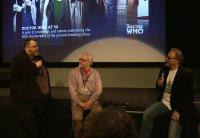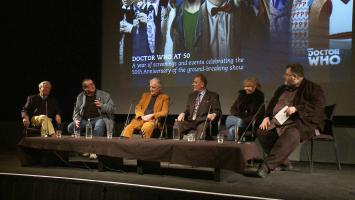 The Mind of Evil. In colour. Yes, that which would have been unthinkable a few short years ago is now a reality – and a triumphant and vibrant one at that, with last Sunday's BFI Southbank première of the sterling, painstaking work done by those dedicated souls on the Doctor Who Restoration Team being the perfect place to celebrate their magnificent achievement.
The Mind of Evil. In colour. Yes, that which would have been unthinkable a few short years ago is now a reality – and a triumphant and vibrant one at that, with last Sunday's BFI Southbank première of the sterling, painstaking work done by those dedicated souls on the Doctor Who Restoration Team being the perfect place to celebrate their magnificent achievement.The frisson among the audience in NFT1 was unmistakeable, the countdown to the start of this significant event almost unbearable – and we weren't let down in the slightest.
Celebrating Jon Pertwee's era as the Doctor, this was the third in the BFI's insanely popular Doctor Who At 50 season, and co-curators Dick Fiddy and Justin Johnson started it off nicely with Fiddy putting things succinctly in context, reminding us that the adventure hadn't actually been seen in colour anywhere in the world for 37 years or in the UK for 42 years. Indeed, no doubt many - if not most - of the audience who had watched it when it was first shown in the UK in 1971 would only have seen it in black-and-white, since colour TV sets were still a luxury back then, so this was a true treat.
 Johnson then introduced Phil Ford, who spoke of Pertwee's background in naval intelligence, thereby putting the seal of authority on the actor's 007 persona as the Doctor.
Johnson then introduced Phil Ford, who spoke of Pertwee's background in naval intelligence, thereby putting the seal of authority on the actor's 007 persona as the Doctor. With six episodes of this action-adventure to get through, the organisers wisely broke the screening down into two-episode chunks, and with anticipation now at fever-pitch the house lights were dimmed and that wonderfully evocative theme music boomed out, with Pertwee's reassuring, smiling face swirling into view and beaming at us in oh-so-glorious colour – just how it should be.
And what a joy it was to behold and luxuriate in – on a 50ft screen too – offering what was, for most people, a refreshingly new perspective on a much-loved adventure. The Mind of Evil. All six episodes in colour once again! Although the evidence was staring me in the face, I had to keep metaphorically pinching myself to be sure that what I was seeing was for real.
The importance of what has been achieved by the Restoration Team really can't be overstated. It has to be remembered that they had their hands tied by the fact that episode one had no hidden "chromadot" colour information to work on - hence that particular episode has been "colourised" - while all six episodes were on 16mm black-and-white film, so what they have achieved is nothing short of miraculous. Showing it on such a massive scale when the story was only made for a 26-inch screen tops did, of course, mean that any slight imperfections would be more than evident, so huge allowances have to be made for that fact. The story was made to be watched on small-screen TV and that's how it should be judged. Not that it was ever on trial, of course, but the verdict remains that it is a resounding triumph.
During his introduction, Ford had also teased the second series of Wizards vs Aliens - it seems viewers could be in for a surprise as regards who they've got writing for it - and following the first two dazzling episodes of The Mind of Evil it was time for some real wizards to be introduced and to take a well-earned bow, as Restoration Team members Peter Crocker, Stuart Humphryes, and Mark Ayres related how they had managed to achieve such a technological marvel. Truth be told, I couldn't understand much of what they said (my general technical inability undoubtedly to blame here, rather than their ability to explain) but I'm darned grateful that there are people out there with the capability, willingness, dedication, and perseverance necessary to put right what once went horribly wrong. Sirs, I salute you all!
A "comfort break" plus quiz with DVDs of Death To The Daleks and Series 7 Part One as prizes followed episodes 3 and 4, and as soon as the end credits had rolled on episode 6 (rapturous applause for all of them, needless to say), tables and chairs were swiftly placed on the stage for the panel interview session with guests director Timothy Combe, script editor Terrance Dicks, plus surviving "UNIT family" members Katy Manning, Richard Franklin, and John Levene.
All were in sparkling form, with the actors' rapport still strikingly evident more than 40 years on, and memories were fondly - and at times poignantly and touchingly - recalled as tributes were paid to Pertwee, Barry Letts, Roger Delgado, and Nicholas Courtney. The panel session should be available on the BFI's YouTube channel in due course, but highlights included Dicks recalling how Pertwee would get cast members to repeat the name "Harry Roy" (a dance band leader) as a voice exercise before recordings - until Combe came along, and "Harry Roy" was usurped by "Tim Combe" as the ideal vocal warm-up! The director, meanwhile, recalled how technical problems led to a reshoot of certain scenes, but only production personnel could be used as there was no money for actors, extras, or even walk-ons - he was killed three times and he also shot his PA!
From start to finish, this première was a real feather in the BFI's cap, so full marks to the organisation for pulling out all the stops to give the audience a truly magical experience.
And finally, if you've been one of those many, many people wanting a ticket to these BFI events but have been left maddened and frustrated by the "Sold out!" sign that you are invariably met with on the information and booking page, don't despair! Returns are not unknown - a few tickets to this event suddenly became available again the preceding Tuesday evening - and there is always the possibility of stand-bys on the day to mop up complimentary tickets that don't get claimed, so do keep persevering. As the Restoration Team have so superbly shown, determination and dedication can reap handsome rewards.










 Circle us on Google+
Circle us on Google+